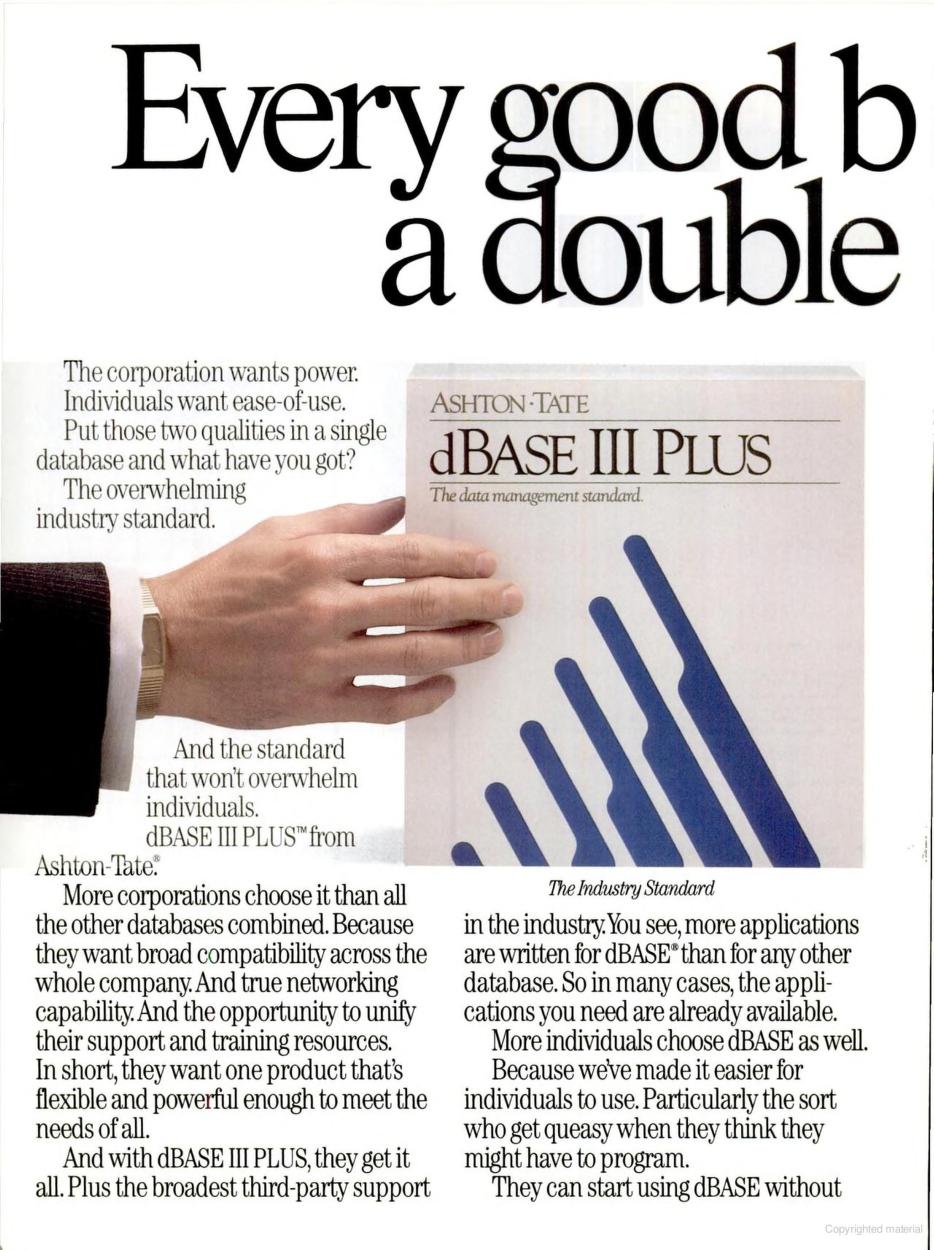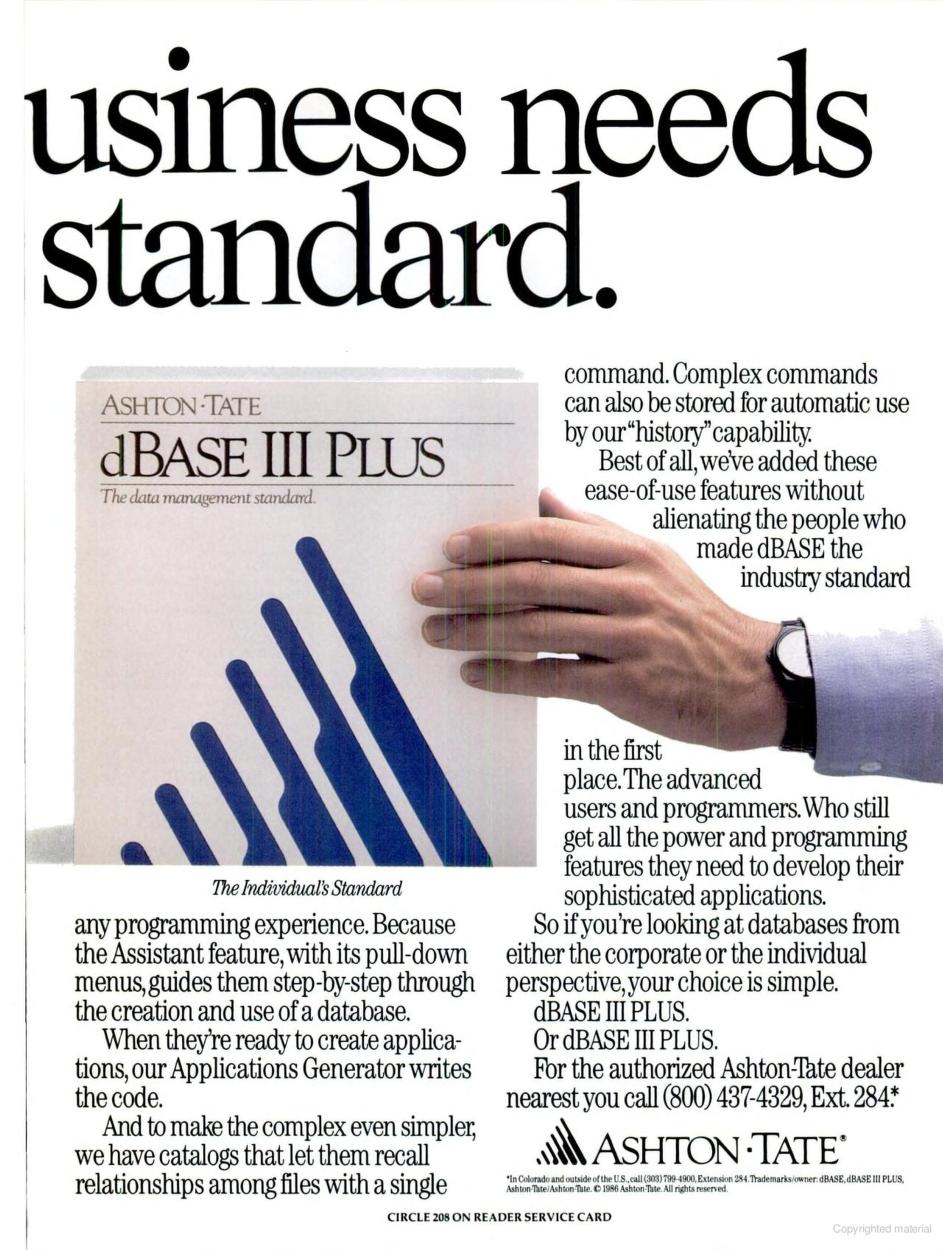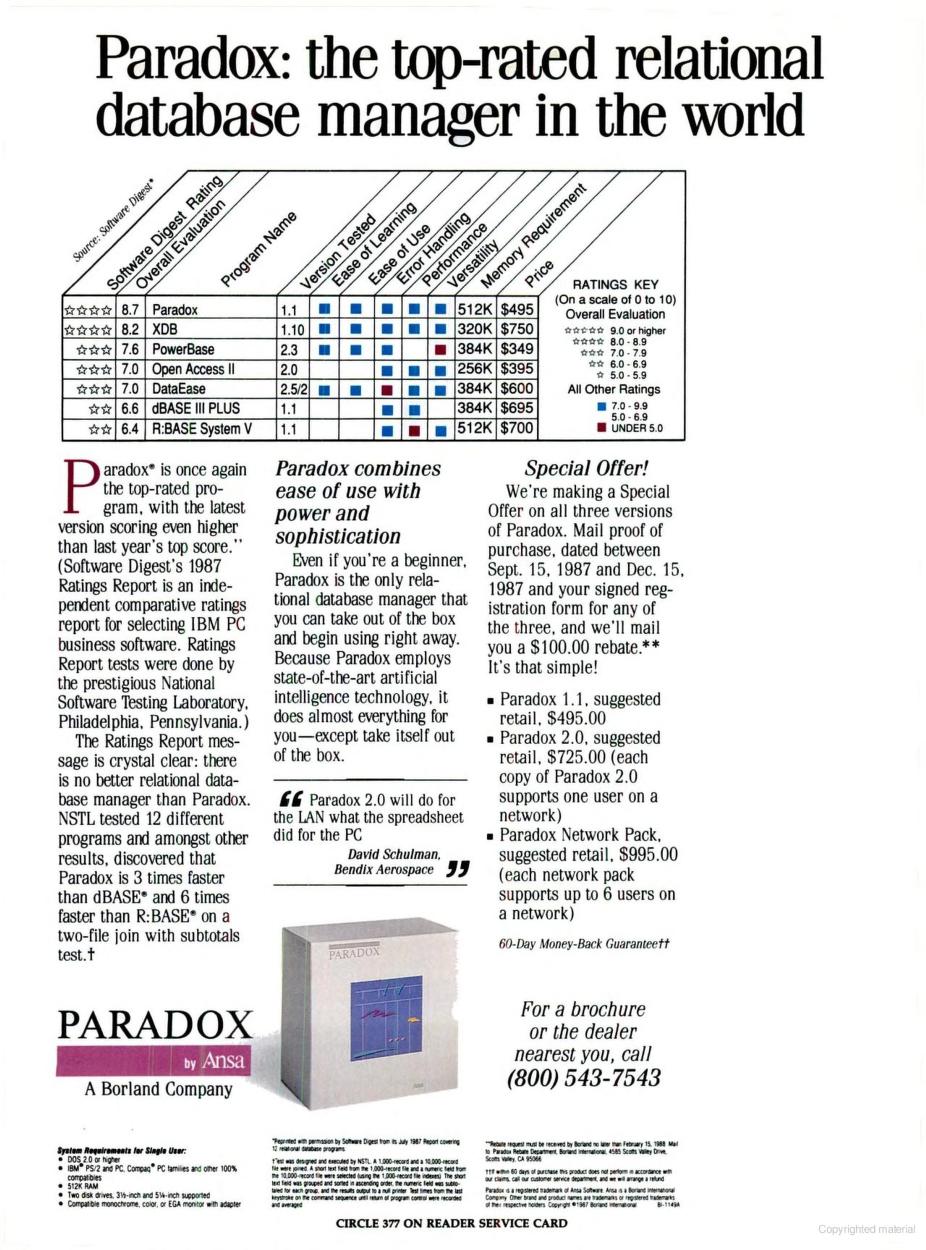 Typical PCs Each Year
Typical PCs Each Year
Margaret Thatcher was re-elected this year, making her the longest serving PM for 100 years, as work on the Channel Tunnel began, and the British Government blocked publication of the SpyCatcher book. Oh yes, and the GSM standard for mobile phone networks was finally agreed, though it would be at least five more years before it entered widespread use. On TV, this year was the inaugoration of 24-hour programming after several trial runs, the BBC premiered the movie WarGames and introduced us to ThunderCats.
On the music scene, Fleetwood Mac released their "Tango in the Night" album, U2 launched "The Joshua Tree", and the year ended with Kylie Minogue's "I Should Be So Lucky".
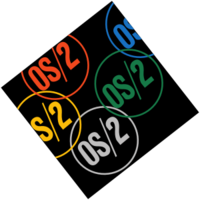
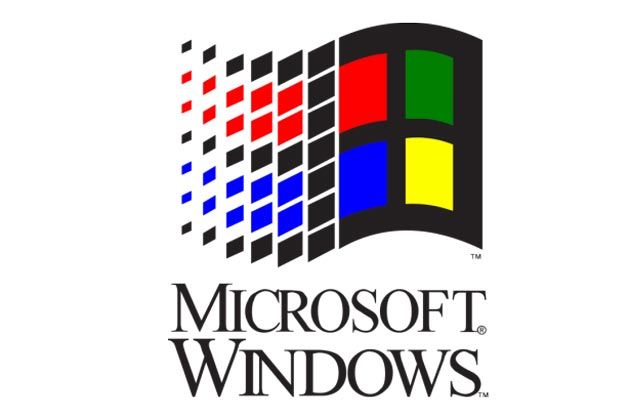
In the world of computing, a lot of key events happened. IBM launched the first PS/2 computer with improved graphics, a 3.5" diskette drive and a new faster Micro Channel Architecture (MCA) bus. Acorn launched their first RISC processor-based Archimedes computer. Connor released the first 3.5" hard disk drive, the CP340A, with a capacity of 40 megabytes. 1987 saw Apple launch the Macintosh II and SE. IBM and Microsoft jointly released the first version of their new operating system, OS/2 though in December this year, Microsoft launched Windows 2.0 to rival it! And let's not forget that the Ad Lib sound card went on sale this year.
Models
In 1987, a budget PC looked something like this:
- Intel 8086 CPU @ 4.77 or 8 MHz
- 512 KB or 640 KB RAM (you could also still pick up 256 KB PCs - see further down for details!)
- Single low-density 5.25" floppy disk drive (360 KB)
- Hercules graphics card with a 12" monochrome monitor (green, white or amber)
- MS-DOS 3.2 or 3.3 (after its release in August this year)
A 4.77 MHz computer would run at about 0.33 MIPS (million instructions per second), or 0.6 MIPS for an 8 MHz microprocessor. Influential PC manufacturers selling to the UK market included Amstrad, Tulip, Akhter, Zenith, Tandon and Viglen.
In the mid-range, a desktop PC comprised the following:
- Intel 80286 CPU @ 8 or 10 MHz (12 MHz was pretty rare, and expensive)
- 1 MB RAM
- 30 MB 40ms hard disk drive
- High-density 1.2 MB 5.25" floppy drive
- MS-DOS 3.2
Moving to the pricier end of the market, a premium PC would have a typical spec of:
- Intel 80386 CPU @ 16 MHz or 20 MHz
- 1 MB or 2 MB RAM
- 20 - 70 MB hard disk drive
- EGA graphics card with a 12" or 14" multisync monitor
- MS-DOS 3.2 or 3.3 (after its release in August this year)
A 386 running at 16 MHz scored a MIPS rating of 5, making it theoretically 15 times faster than the original IBM 5150. These premium PCs would often come with an early version of Windows 2.0 - Windows/386 wouldn't launch until Decemer 1987(?). Apricot, Olivetti and Elonex also sold into this market.
Motherboards
Back in 1987 it was uncommon to buy a motherboard - consumers tended to buy the whole computer, or at least the system unit with no monitor or keyboard, since there were many third party companies churning out pre-built XT- and AT- compatibles for decently low prices.
Still, some places did sell motherboards. Here are some prices:
- Super Turbo XT 4.77/8 MHz with up to 640 KB RAM support = £149 (no CPU, no RAM)
- Small Footprint PC/AT compatible 6/8/10 MHz = £499 (no CPU, no RAM)
- Baby AT motherboard, no RAM, includes Award BIOS ROM = $399.95 (no CPU, no RAM)
- Novas NEAT Turbo 286-16 motherboard (10 MHz = 0 wait state, 16 MHz = 0.6 wait states) = $510 (no CPU, no RAM)
- Novas Turbo 286-12 motherboard (0 wait state), Norton SI rating of 15.7, C&T chipset = $475 (no CPU, no RAM)
- Novas Turbo 386-16 w/ 1 MB RAM board, AT-size = $1,395 (CPU and RAM included)
Laptops
Toshiba was the leader of the pack when it came to laptop computers. By 1987, they had managed to shrink a PC down to something that really was usable on the move, both light in weight and no less powerful than a desktop PC. You had to have deep pockets, however - their T3100 286 would set you back around $3,000.
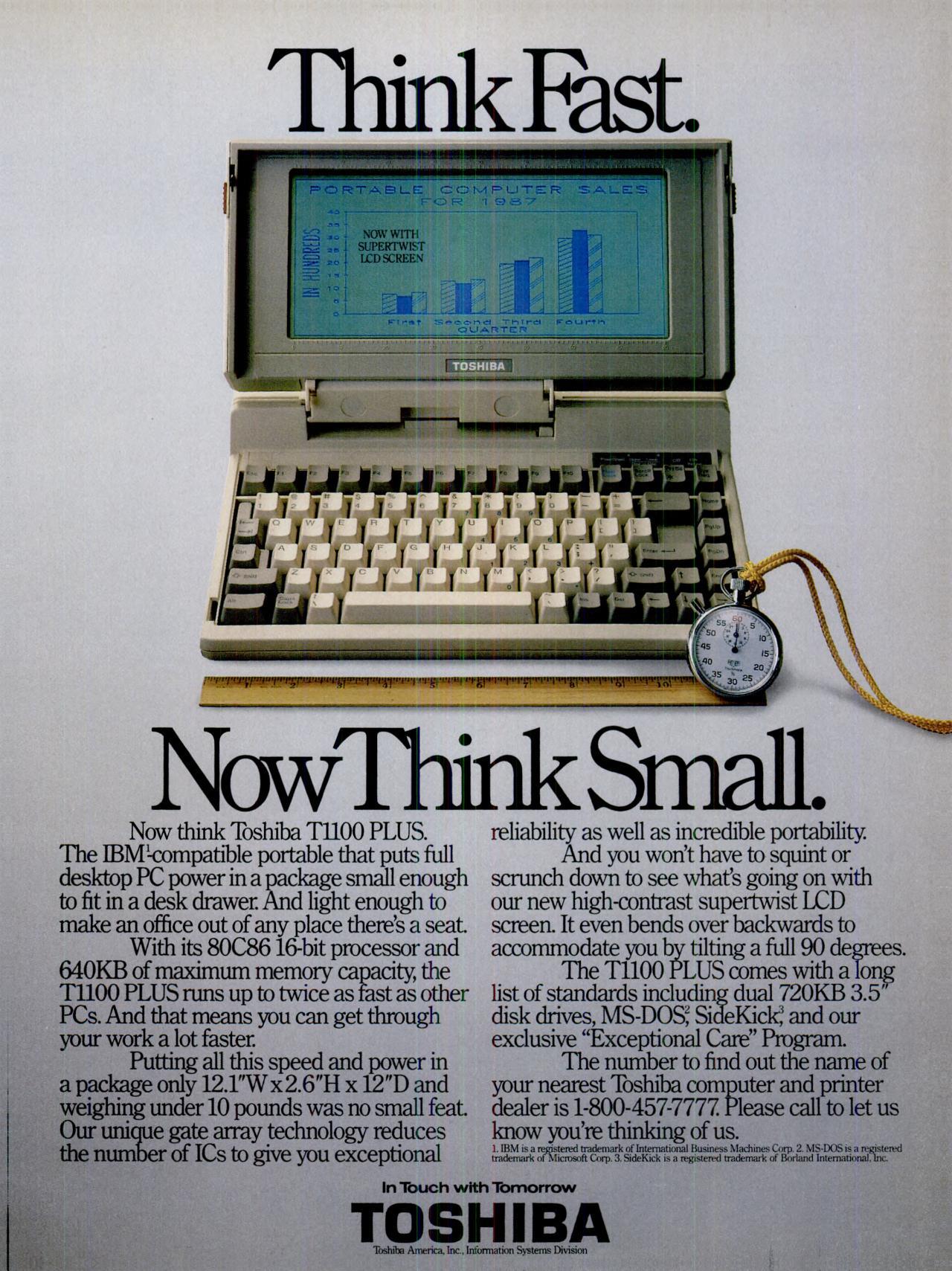
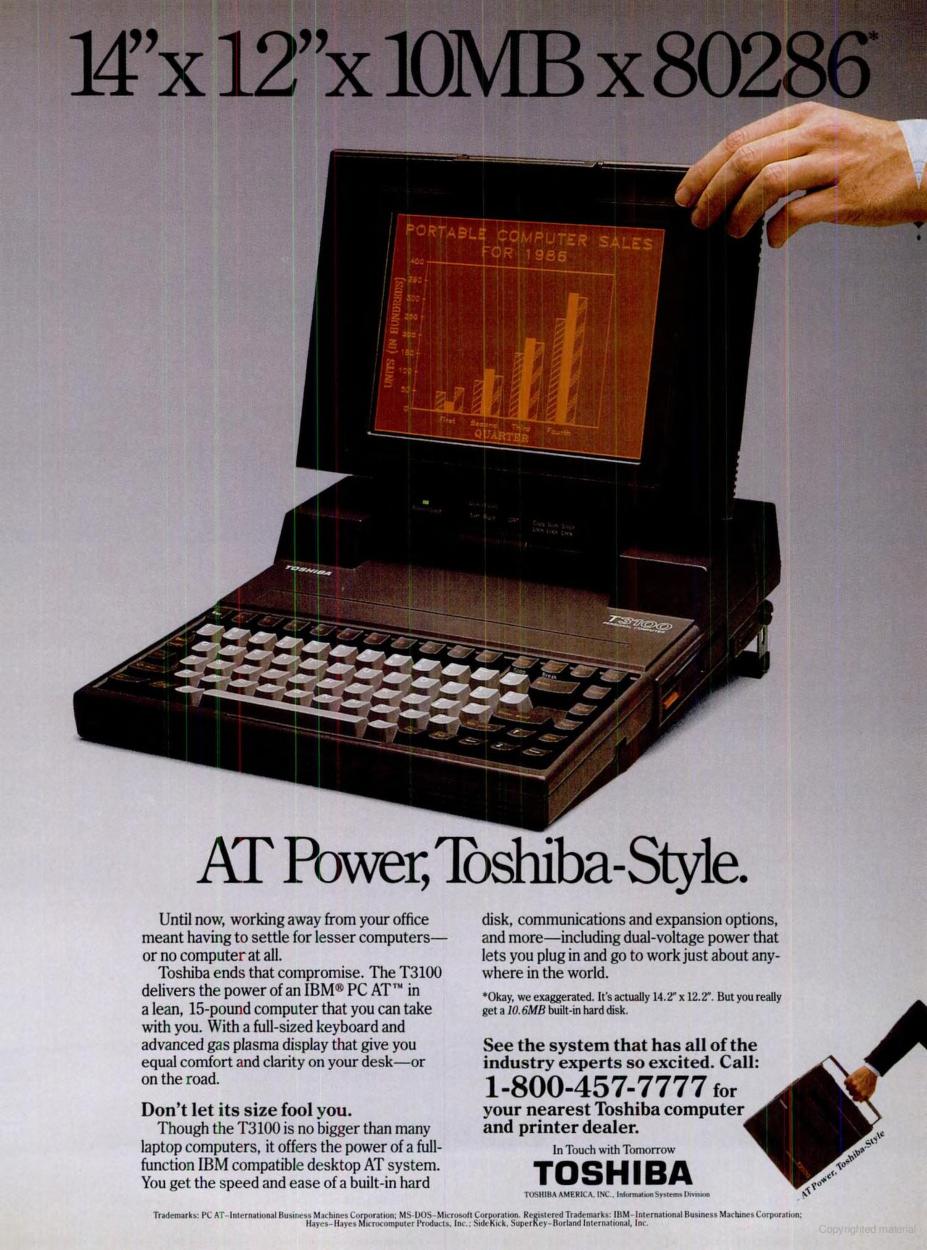
Toshiba T1100 Plus (left) and T3100 (right)
For a trip down memory lane with Toshiba laptops, see my two-part article dedicated to Toshiba.
Printers
Dot matrix printers continued to be all the rage in 1987 - all still black & white only. Epson dominated in this space, with printers as fast as 300 cps (characters per second). The highest quality dot matrix printers were those with 24 pins, while more budget-oriented models continued to have just 9 pins. The advantage of dot matrix printers was that they could print anything, including graphics - something daisywheel printers could not. Dot matrix printers worked by striking the page with a printhead comprising a matrix of dots. A ribbon containing the ink would sit between the printhead and the paper so that when the printhead struck it left an impression of ink on the paper for the dots that were pronounced. A 9-pin dot matrix printer had a single column of 9 vertical pins, whereas a 24-pin one has two closely-coupled columns each having 12 pins. The more pins your printer had, the finer/better quality the output since each character was made up of more dots. A daisywheel printer worked in a similar way with a hammer striking the paper with an ink ribbon in between, but the character impression to be printed was set by a wheel that held the full set of characters on it. This wheel would be rotated around so that the correct character aligned with the hammer before it was struck. To print in a different font, the wheel had to be removed and replaced with a different one. Because each wheel only contained the alphanumeric character set, the printing of graphics was not possible on this type of printer, however the quality of text-only output was higher than with dot matrix.
Anyone with a bigger budget may have opted for a laser printer, which could print at up to 8 ppm (pages per minute). The biggest sellers were HP, but Canon and Epson also had laser printer offerings.
At the cheapest end of the printer market was the Panasonic 1081, which printed at 120 cps and sold for just £155. For those who needed high text-only printing speeds without graphics, daisywheel printers were still available. Juki sold their daisywheel models 6100, 6200 and 6300 (different speeds) for £275, £425 and £635 respectively.
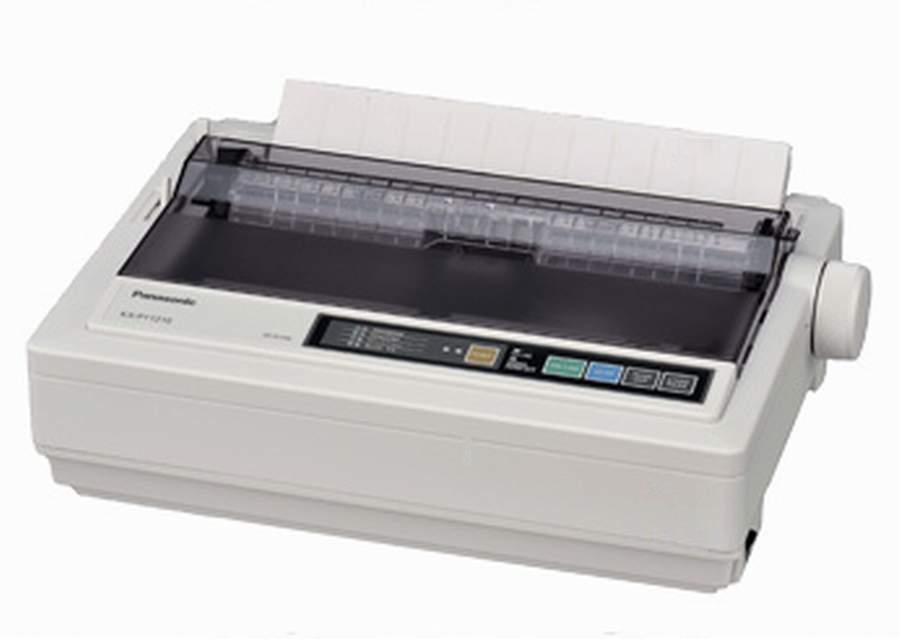
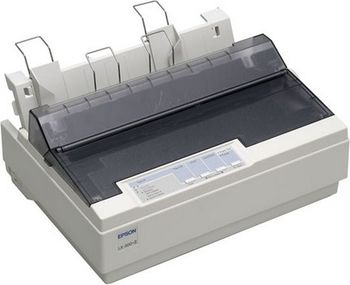
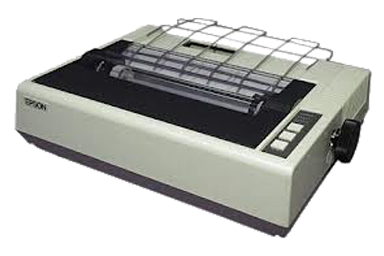
(From Left to Right): Panasonic 1081, Epson LX800, and Epson FX800
Epson's LX800 was a NLQ (Near Letter-Quality) printer that could print at 150 cps, and had a typical price of £195. Mid-range ones with speeds of 200 cps like the Epson FX800 were £305. To get 300 cps but still NLQ, the Epson EX800 sold for £395. These were all 9-pin dot matrix printers. To get the better LQ (Letter Quality) you had to go for the Epson LQ1000 which was £555 or the LQ2500 (faster) for £725.
On the laser printer front, HP's Laserjet Series 2 sold for £1,895. Canon's LBP Series 2 sold for a little less at £1,595, whilst Epson's GQ3500 (6 ppm) sold for £1,495.
Other printer brands available in 1987 included Star Micronics, Oki (the Microline range), Diconix who produced early portable inkjet printers, Citizen, Brother and NEC (the Pinwriter range).
Monitors
In 1987 the choice of graphics cards and monitors was expanding. Graphics capabilities ranged from Hercules monochrome, to 4-colour CGA (640 x 200), and at the top end, 16-colour EGA in 640 x 350 resolution. Monitor sizes started at 10" diagonal and went up to 14" diagonal at the top of the range.
At the low end the 10" diagonal Philips 7513 monochrome monitor sold for just £69. Their popular CGA-compatible one, model 8833 which supported up to 640x200 resolution sold for £225.
If you wanted a typical EGA (non-multisync) monitor, Mitsubishi's 1440 Enhanced Colour Monitor sold for £425. Being a fixed-sync monitor, you could not use this to display MDA, Hercules or CGA graphics modes.
An NEC Multisync monitor would set you back £460.
Taxan MultiScan monitors were £550.
Sony Multiscan was up at £625.
But you could get a cheap multi-scan EGA monitor such as the Eizo ER8042H 14" ultra-high res EGA colour monitor which cost just £336 - quite the bargain!
If you shopped around you could bag an EGA card with 256 KB of video memory and a 14" EGA monitor for as cheap as $479 in the U.S.
Monitors in the U.S. were similarly-priced:
An NEC Multisync 1401 was $529, while the Multisync Plus was $869.
A Mitsubishi XC-1409 CGA monitor would cost $329; the XC-1410/1430 EGA monitors were $399/$449 respectively.
A Sony Multiscan 1302 cost $599, and a Taxan 635/650 was $349/$399 respectively.
At the bottom end, a Samsung mono TTL amber monitor was just $69.
At the upper end of the price range, an NEC Multisync XL 19" EGA monitor cost $1,996.
Other known brands that were US-only were Amdek and Princeton.
Hercules as a company were still doing very well in 1987. They sold their Mono Graphics Plus card for £189, whilst their "InColor" sold for £290. ATI's EGA Wonder was considered quite a premium card at the time - this sold for £249.
Hard Disks
Both hard disks and hard "cards" (a hard disk physically mounted side-on on the hard disk controller expansion card) were available in 1987. Dyson, Miniscribe, Western Digital and Seagate were the big players. You could buy 20 MB of storage on a hard disk for £225 (Seagate ST-225 including controller and cables). For a hard card equivalent if you didn't have free drive bays, it was usually more: a Plus 20 MB hardcard cost £525 and for 40 MB was a whopping £850, but for the budget-conscious a Dyson 20 MB File Card was just £279, A Miniscribe 32 MB hard disk was a bargain £289 or you could go for the Seagate ST-251 40 MB hard disk for £350 (drive only). In the US, these sold for $495 (drive only).
Miniscribe's hard card range was called "ScribeCard" - available in 20 MB or 30 MB capacities, but relatively slow at 61ms access time. Prices were $389 and $419 respectively.
For XT systems, you could get a Miniscribe 3650 which was a 40 MB hard disk for $399 including an 8-bit hard disk controller card and cables. This had an access time of 61ms.
The fastest hard disks in 1987 provided 28ms access times, but the norm was still 40ms.
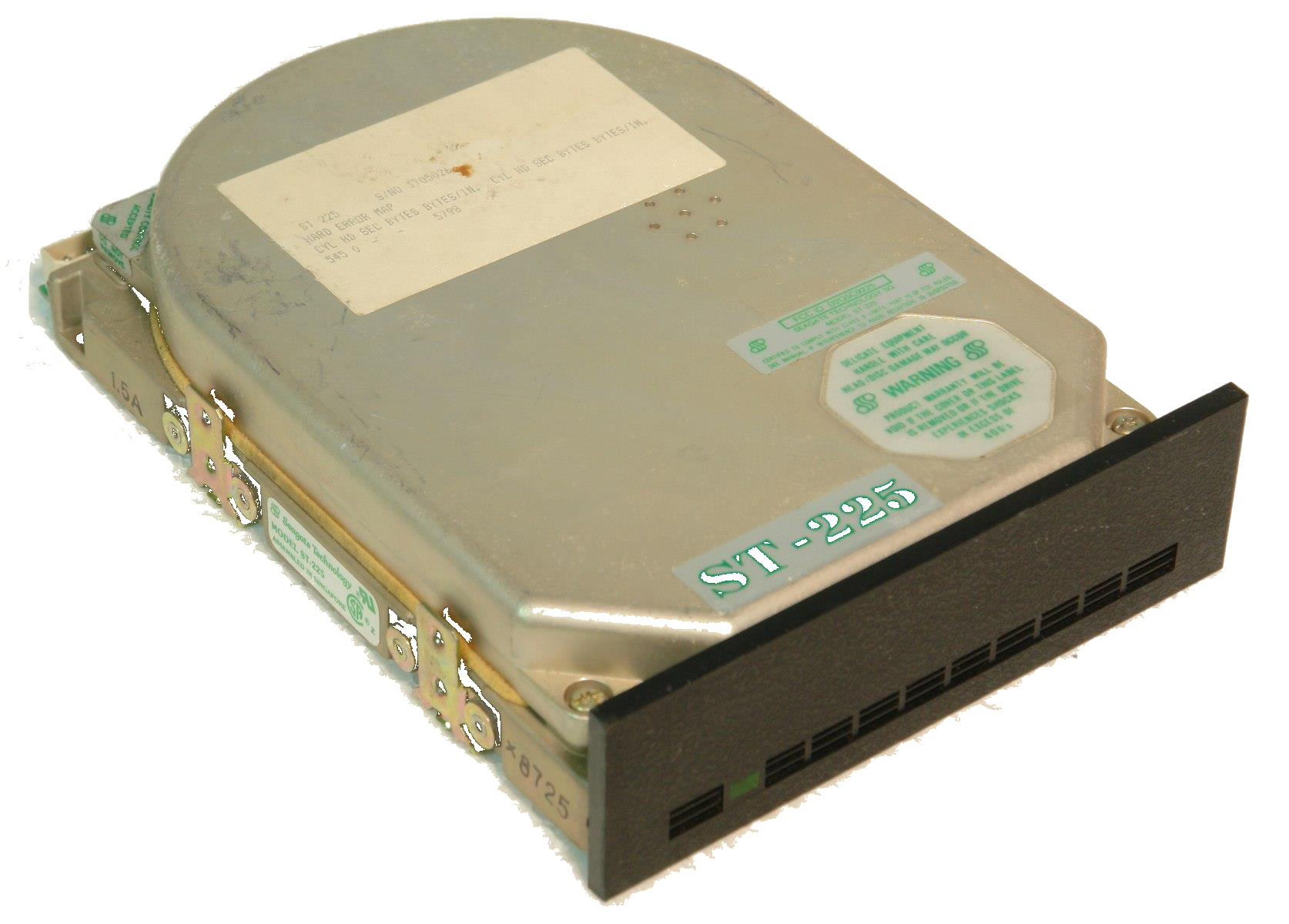
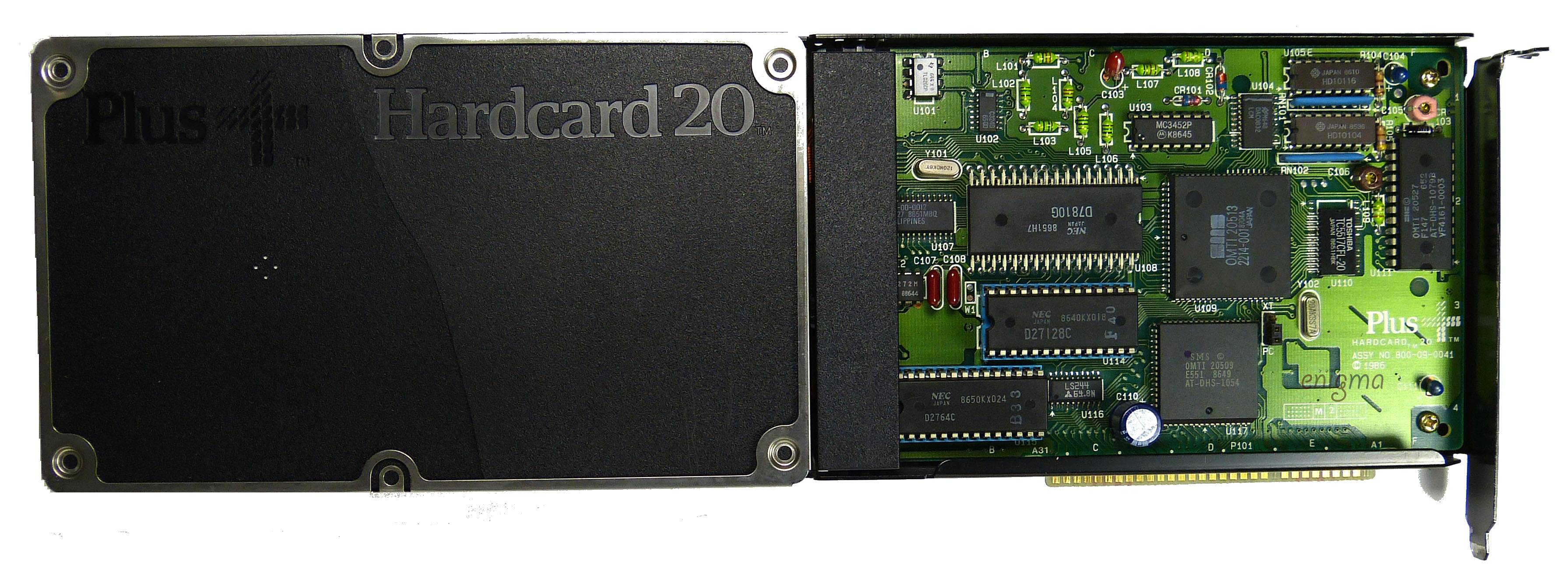
Seagate ST-225 hard disk (left), and a Plus Hardcard 20 (right)
So typically the cost this year was between £8.75 and £12.50 per megabyte. As you would expect, the more capacity you bought the cheaper per megabyte.
Modems
1200 baud modems were still to norm and cost around $120 to $140, but 2400 baud offered greater performance while costing about $100 more.
Software
Ashton-Tate's dBase III Plus, at around $389, was a very popular database for power users in 1987, alongside Borland's Paradox 2.0, which retailed for $439.
WordPerfect 4.2 was top of the software charts in the word processing category, though WordStar 4.0 was still a serious competitor with a loyal following. Both these products had arrived the year before with no new offerings for 1987.
In the world of spreadsheets there was really only one option: Lotus 1-2-3. We were graced not with one but two choices: Release 2.2 arrived this year. (Borland's Quattro wouldn't arrive until 1988). Release 2.2 offered better performance, automated macro tools, and presentation-quality graphics. Alongside this was 1-2-3 Release 3.0 which marked the transition from being written in Assembler to C. Because of this, Release 3.0 required a more powerful PC to run it, hence why Lotus chose to release two versions alongside each other to accommodate PC users of all budgets. There were other spreadsheet programs available such as CA SuperCalc 4.
For programmers, Borland released the first version of Turbo BASIC along with their Turbo Toolbox series of libraries. The faster Turbo Pascal v4.0 also arrived in 1987 with its own set of toolboxes.
On many peoples' PCs you might also find Norton Commander - a convenient set of utilities to find and manipulate files more easily using point and click (well ok, using the cursor keys) - or the popular Norton Utilities which extended the provided DOS commands with a lot more functionality such as undelete, find and file editors.
In the games category we were treated with some excellent titles in 1987 including Sierra's Police Quest: In Pursuit of the Death Angel, Sid Meier's Pirates!, Electronic Arts' Test Drive and Spectrum Holobyte's Falcon.
Other Stuff
You could get an Intel 8087 math co-processor for £95 (5 MHz) to £135 (8 MHz), or an 80287-8 for £185.
The popular AST SixPack Plus 64 KB memory multifunction card was available for £165, or the Intel AboveBoard with no RAM installed was £199.
UK DESKTOP PC Prices
Cheapest/Clearance PCs
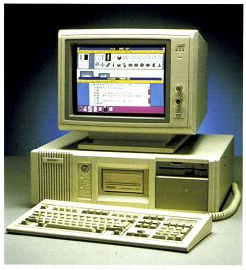 Tandon PCX20
Tandon PCX20
640 KB RAM, 8086 @ 4.77 MHz, 20 MB HDD, 360 KB floppy, Hercules graphics card, 12" monochrome monitor: £895 (for EGA add £295).
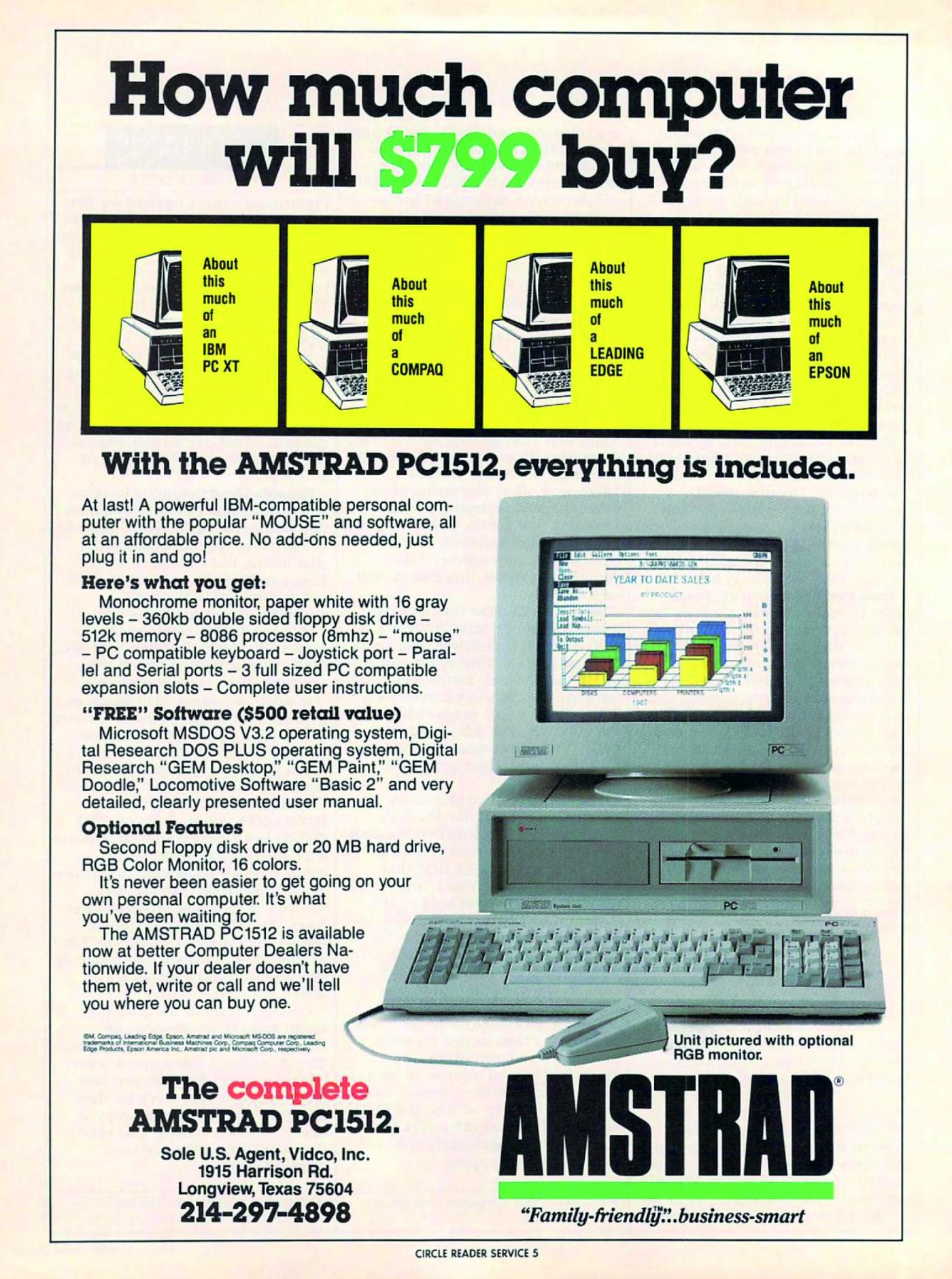 Amstrad PC1512HD
Amstrad PC1512HD
8086 @ 8 MHz, 512 KB RAM, 20 MB HDD, 360 KB floppy drive, 12" mono monitor. £845
Amstrad PC1640SD
8086 @ 8 MHz, 640 KB RAM, 360 KB floppy drive, EGA graphics, 12" mono monitor. £695
Amstrad PC1640DD
8086 @ 8 MHz, 640 KB RAM, 2 x 360 KB floppy drives, EGA graphics, 12" mono monitor. £795
Amstrad PC1640HD
8086 @ 8 MHz, 640 KB RAM, 20 MB HDD, 360 KB floppy drive, EGA graphics, 12" mono monitor. £995
For all of the above, to replace mono with CGA add £165.
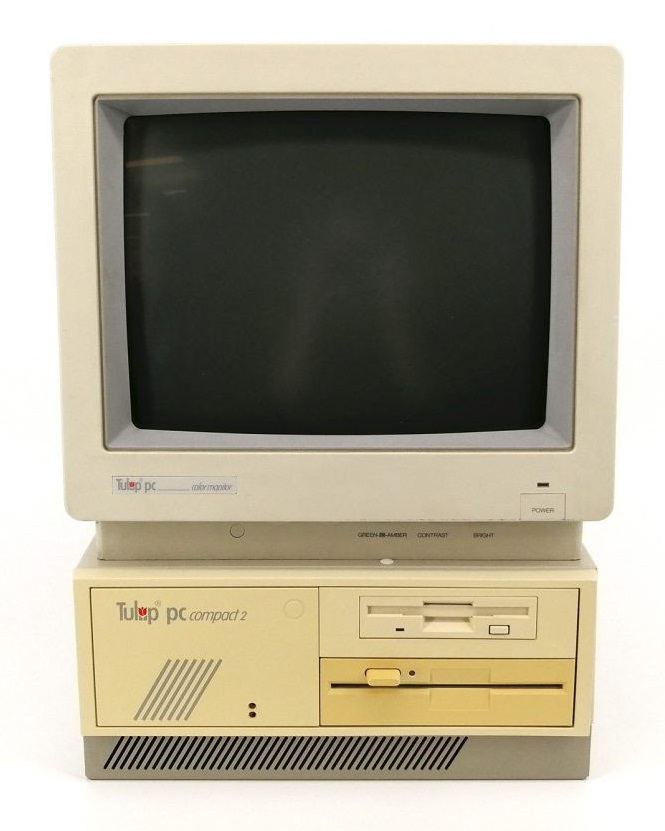 Tulip pc compact 2
Tulip pc compact 2
8086 @ 9.5 MHz, 640 KB RAM, 20 MB HDD, 360 KB floppy, EGA graphics, no monitor
£995
For EGA multisync monitor, add £595
| Akhter PC 1000 | 8088 @ 8 MHz, 256 KB RAM, single 360 KB floppy drive, Hercules graphics card, 150W PSU and 8 expansion slots. No monitor. | £495 |
| Akhter PC 1500 | 8088 @ 8 MHz, 256 KB RAM, dual 360 KB floppy drives, Hercules graphics card, 150W PSU and 8 expansion slots. No monitor. | £595 |
| Akhter PC 2000 | 8088 @ 8 MHz, 512 KB RAM, 20 MB HDD, single 360 KB floppy drive, Hercules graphics card, 150W PSU and 8 expansion slots. No monitor. | £795 |
| Akhter PC 3000 | 8088 @ 8 MHz, 512 KB RAM, dual 720 KB 3.5" floppy drives, Hercules graphics card, 150W PSU and 8 expansion slots. No monitor. | £645 |
| Elonex PC 88 | NEC V20 4.77/8 MHz, 640 KB RAM, 20 MB 65ms hard disk, 360 KB floppy drive, Hercules-compatible mono graphics card, HiRes 12" mono monitor, mouse, professional keyboard, MS-DOS 3.21, GEM collection | £795+VAT |
| Viglen VPC 10M | NEC V20 4.77/8 MHz, 256 KB RAM, 360 KB floppy drive, mono monitor. MM-211 Amber monitor option for £86.15. | £539 |
| Viglen VPC 100M | NEC V20 4.77/8 MHz, 1 MB RAM, 2 x 360 KB floppy drives, 2 parallel and serial ports, game port and a realtime clock. Mono monitor. MM-211 Amber monitor option for £86.15. | £679 |
| Viglen VPC 120M | NEC V20 4.77/8 MHz, 1 MB RAM, 20 MB hard disk, 360 KB floppy drive, 1 parallel and 2 serial ports, game port and a realtime clock. Mono monitor and MS-DOS 3.2. MM-211R Paper White monitor option for £85.15. | £949 |
| Zenith Eazy PC | 8088 @ 8 MHz, 640 KB, 20 MB HDD, 3.5" 720K floppy drive, mono monitor. | £899 |
| (unbranded) XT-compatible | 8088 @ 10 MHz, 512 KB RAM, 2 x 360 KB floppy drives, mono graphics card, 12" hi-res green or amber monitor, 84-key keyboard, MS-DOS 3.1, 8 expansion slots, Phoenix BIOS. | £495 |
Mid-Range PCs
| Tandon PCA20 | 640 KB RAM, 80286 @ 8 MHz, 20 MB HDD, 1.2 MB floppy, Hercules graphics card, 12" mono monitor (for EGA add £295) | £1,195 |
| Tandon PCA30` | 640 KB RAM, 80286 @ 8 MHz, 30 MB HDD, 1.2 MB floppy, Hercules graphics card, 12" mono monitor (for EGA add £295) | £1,495 |
| Tandon PCA40 | 640 KB RAM, 80286 @ 8 MHz, 40 MB HDD, 1.2 MB floppy, Hercules graphics card, 12" mono monitor (for EGA add £295) | £1,695 |
| Tandon PCA70 | 640 KB RAM, 80286 @ 8 MHz, 70 MB HDD, 1.2 MB floppy, Hercules graphics card, 12" mono monitor (for EGA add £295) | £1,995 |
| Apricot Xen i286 | 80286-10 MHz, 1 MB RAM, 30 MB HDD, 1.2 or 1.44 MB floppy, mono monitor (replace mono with paper white add £145, for EGA £750) | £1,895 |
| Tulip AT20 | 80286 @ 10 MHz, 640 KB RAM, 20 MB HDD, 1.2 MB floppy, EGA graphics, no monitor (for EGA multisync monitor, add £595) | £1,495 |
| Tulip AT40 | 80286 @ 10 MHz, 640 KB RAM, 40 MB HDD, 1.2 MB floppy, EGA graphics, no monitor (for EGA multisync monitor, add £595) | £1,795 |
| Akhter PC AT | 80286 @ 6/8/10 MHz, 1 MB RAM, 20 MB HDD, EGA graphics card, 102-key enhanced keyboard, MS-DOS and monochrome monitor. | £1,295 |
| Elonex PC 286 | 80286 6/8/10 MHz zero wait state, 640 KB RAM, 40 MB 40ms hard disk, 1.2 MB floppy drive, Hercules-compatible mono graphics card, HiRes 14" mono monitor, mouse, professional keyboard, MS-DOS 3.21, GEM collection | £1,295+VAT |
| Olivetti M24 | 8086 CPU, 640 KB RAM, 20 MB HDD, Olivetti monitor and keyboard, MS-DOS | £1,295 |
| Viglen AT 286iM | 80286 6/8/10/12 MHz switchable, 1 MB RAM, 1.2 MB floppy disk drive, 20 MB hard disk, 1 parallel and 2 serial ports. Mono monitor and MS-DOS 3.2. VA-078 EGA card and colour monitor add £449. | £1,499. |
| Zenith Z-286 | 80286 @ 10 MHz, 512 KB RAM, 20 MB HDD, hi-res monitor, keyboard, MS-DOS, Windows | £1,545 |
| (unbranded AT-compatible) | 80286 CPU @ 6/10 MHz, 640 KB RAM, 20 MB Seagate HDD, TEAC 1.2 MB floppy drive, mono graphics card, 14" green or amber monitor, 102-key keyboard, MS-DOS 3.1 | £1095 |
Premium PCs
 Tandon 386
Tandon 386
80386 @ 16 or 20 MHz, 2 MB RAM, 112 MB HDD, 1.2 MB floppy disk drive, Hercules graphics card (for EGA add £295), 14" monochrome monitor (colour monitor is an option).
UK price in 1987: £?
FR price in Jul 1988: 59.990F (mono), 63.490F (colour EGA), add 2.500F for 30 MB Data Pac or 3.900F for the 40 MB Data Pac.
Only available on Tandon 386, it had a unique feature: the "Personal Data Pac" - a smaller removable hard drive which was in addition to the fixed hard drive. The Tandon 386 was available in 16 and 20 MHz versions, and got 2 MB of RAM which came on a proprietary card that did not occupy an ISA expansion slot. Using these cards meant you could upgrade to a maximum 8 MB of RAM. It also came with 64 KB of 35ns cache RAM, a 112 MB RLL hard disk drive, and a 5.25" high-density floppy drive - 3.5" drives (720 KB or 1.44 MB) would be available in the first half of 1988. As on the Target 286 and Pac 286 models, the standard monitor was monochrome (720 x 348); a colour monitor and an EGA card were available as a cost option. GW Basic, MS-DOS and MS Windows software came bundled with the Tandon 386.
Some other premium PCs available at the time are listed here:
| Apricot Xen i286 | 80286-10 MHz, 1 MB RAM, 45 MB HDD, 1.2 or 1.44 MB floppy, mono monitor (replace mono with paper white add £145, for EGA £750) | £2,795 |
| Apricot Xen i386 | 80386-16 MHz, 1 MB RAM, 30 MB HDD, 1.2 or 1.44 MB floppy, mono monitor (replace mono with paper white add £145, for EGA £750) | £2,695 |
| Apricot Xen i386 | 80386-16 MHz, 2 MB RAM, 45 MB HDD, 1.2 or 1.44 MB floppy, mono monitor (replace mono with paper white add £145, for EGA £750) | £3,495 |
| Elonex PC 386 | 80386-16 MHz, 2 MB RAM, 44 MB 28ms hard disk, 1.2 MB floppy drive, Hercules-compatible mono graphics card, HiRes 14" mono monitor, mouse, professional keyboard, MS-DOS 3.21, GEM collection | £2,495+VAT |
| Tulip AT386 | 80386 @ 16 MHz, 2 MB RAM, 30 MB HDD, 1.2 MB floppy, EGA graphics, no monitor (for EGA multisync monitor, add £595) | £2,595 |
| Viglen AT 386M | 80386 6-16 MHz switchable, 2 MB RAM, 1.2 MB floppy disk drive, 1 parallel and 2 serial ports and a clock. Mono monitor, MS-DOS 3.2 and Microsoft Windows with mouse. VA-073 Multiscan monitor add £499. | £2,995 |
| Zenith Z-386 | 80386 @ 16 MHz, 1 MB RAM, 40 MB HDD, colour monitor (£3,495 with no HDD) | £3,925 |
US DESKTOP PC Prices
Cheapest/Clearance PCs
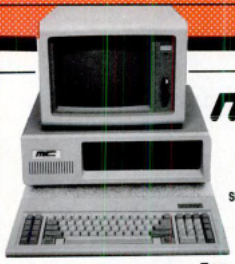 MIT Systems Turbo PC/XT (sold through Telemart)
MIT Systems Turbo PC/XT (sold through Telemart)
256 KB RAM, 8088 @ 10 MHz (keyboard-switchable from 4-10 MHz), 135W power supply, single brand name 360 KB floppy drive, AT-style keyboard, 8 expansion slots. No graphics card or monitor. $346 (though base model with mono graphics and monitor was $490 - see below).
With 640 KB: $405, with 640 KB and two floppy drives: $475.
With
640 KB, two floppies and 20 MB hard disk: $725, or with 30 MB hard disk: $755.
Mono graphics card w/ printer port: Add $55, Auto-switch EGA card: Add $145.
Amber monitor: Add $89, Color monitor: Add $255.
CompuAdd Standard Turbo/8
Keyboard-selectable 4.77-8 MHz, AT-style keyboard, 256 KB RAM (expandable to 640 KB on motherboard), 8 expansion slots, Intel 8088, one 5.25" 360 KB floppy drive with controller. $399.
CompuAdd Standard Turbo/10
Keyboard-selectable 4.77-10 MHz, AT-style keyboard, 640 KB RAM, 8 expansion slots, Intel 8088, one 5.25" 360 KB floppy drive with controller, system reset button. $495.
For the above two CompuAdds:
Add Standard brand monographics video card w/ parallel port: $65.
Add 12" flat screen Samsung mono monitor w/ tilt/swivel base: $95 (or buy the combo mono card/monitor: $139).
Add Standard brand CGA video card w/ parallel port: $69.
Add 12" CGA color monitor: $315 (or buy the combo CGA card and monitor: $359)
Add Standard brand EGA video card w/ 256 KB display RAM: $149.
Add 14" high-resolution EGA color monitor: $349 (or buy the combo EGA card and monitor: $479)
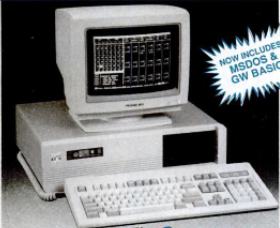 Swan XT10
Swan XT10
640 KB RAM, 8088-1 @ 10 MHz, 150W power supply, two 360 KB floppy drives, Hercules graphics card, 12" tilt/swivel amber monitor, 1 serial port, 1 parallel port, 1 game port, clock/calendar w/ battery backup, 101-key Enhanced "AT" touch & click style keyboard.
$749
With a 20 MB Seagate hard disk: $949, with a 30 MB Miniscribe hard disk: $999.
Base unit w/o monitor or video card: $519
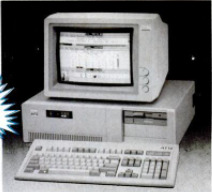 Swan AT12
Swan AT12
640 KB RAM (upgradable to 1 MB), 80286 @ 10/12 MHz (keyboard-switchable) - 11.7 Norton SI rating, 200W power supply, single 360 KB floppy, Hercules graphics card, 12" amber monitor, 2 serial ports, 1 parallel port, 1 game port, clock/calendar w/ battery backup, 101-key Enhanced "AT" touch & click style keyboard, dual floppy/dual hard drive controller. $1,099.
With a 40 MB Miniscribe 3650 hard disk: $1,499, with a 40 MB Seagate hard disk (ST-251): $1,649.
Base unit w/o monitor or video card: $949
Upgrade from Hercules to CGA and RGB color monitor: Add
$170
Upgrade from Hercules to EGA and Packard-Bell EGA monitor: Add
$399
| Tandon PCX20 | 640 KB RAM, 8086 @ 4.77 MHz, 20 MB HDD, 360 KB floppy, Hercules graphics card, 12" mono monitor | $1,595 |
Standard PCs
Other Stuff
| Hard Disks | 20 MB Seagate ST-225 Drive w/ controller | $289 |
| Hard Disks | 30 MB Miniscribe XT Drive w/ controller | $339 |
| Hard Disks | 30 MB Seagate ST-238 Drive w/ controller | $359 |
| Hard Disks | 40 MB Miniscribe AT Hard Card | $379 |
| Hard Cards | 30 MB Miniscribe Hard Card | $429 |
| Hard Cards | 20 MB Western Digital File Card 20 | $439 |
| Hard Cards | 30 MB Miniscribe AT Hard Card | $479 |
| Hard Disks | Seagate ST-4038 AT Drive | $549 |
| Hard Disks | 40 MB Seagate ST-251 AT Drive | $469 |
| Hard Disks | 42 MB Miniscribe Hard Drive (28ms access time) | $575 |
| Hard Disks | 70 MB Miniscribe Hard Drive (28ms access time) | $849 |
| Monitors | Amdek 410A Amber Green or White monochrome monitor | $149 |
| Monitors | Packard-Bell Amber monitor w/stand | $97 |
| Monitors | Samsung TTL monochrome monitor | $89 |
| Monitors | Xtron Amber TTL/CGA autoswitch [mono] monitor | $119 |
| Monitors | Magnavox 8562 RGB colour monitor | $269 |
| Monitors | Magnavox 8515 RGB colour monitor | $289 |
| Monitors | Zenith 1330 RGB colour monitor | $407 |
| Monitors | Zenith 1470 EGA monitor | $219 |
| Monitors | NEC Multisync EGA monitor | $? |
| Monitors | Amdek 722 EGA monitor | $477 |
| Monitors | Thomson Ultrascan EGA monitor | $499 |
| Graphics Cards | ATI Graphics Solution card | $169 |
| Graphics Cards | ATI EGA Wonder card | $274 |
| Graphics Cards | BOCA Research EGA/CGA/MDA/MGA card | $149 |
| Graphics Cards | Hercules Graphics Plus card | $179 |
| Graphics Cards | Hercules Color Card | $147 |
| Graphics Cards | Paradise Autoswitch 360 | $149 |
| Graphics Cards | Paradise Autoswitch 480 | $169 |
| Graphics Cards | STB EGA+ | $259 |
| Graphics Cards | Chauffeur HT | $214 |
| Math Coprocessors | 8087-3 | $129 |
| Math Coprocessors | 8087-2 | $159 |
| Math Coprocessors | 80287-6 (6 MHz) | $219 |
| Math Coprocessors | 80287-8 (8 MHz) | $269 |
| Floppy Drives | 5.25" 360 KB floppy for PCs (black faceplate) | $99 |
| Floppy Drives | 5.25" 360 KB floppy for ATs (grey faceplate) | $109 |
